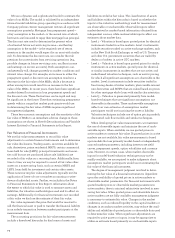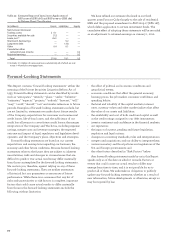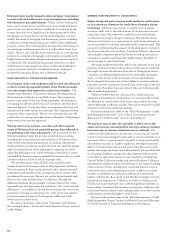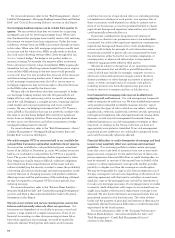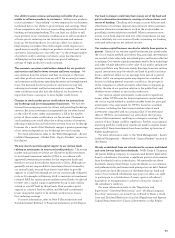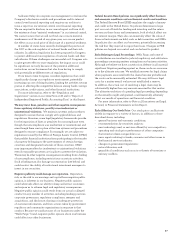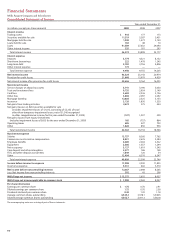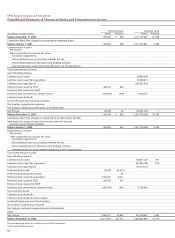Wells Fargo 2009 Annual Report Download - page 87
Download and view the complete annual report
Please find page 87 of the 2009 Wells Fargo annual report below. You can navigate through the pages in the report by either clicking on the pages listed below, or by using the keyword search tool below to find specific information within the annual report.
Our ability to grow revenue and earnings will suffer if we are
unable to sell more products to customers. Selling more products
to our customers—“cross-selling”—is very important to our business
model and key to our ability to grow revenue and earnings. Many
of our competitors also focus on cross-selling, especially in retail
banking and mortgage lending. This can limit our ability to sell
more products to our customers or influence us to sell our products
at lower prices, reducing our net interest income and revenue
from our fee-based products. It could also affect our ability to
keep existing customers. New technologies could require us to
spend more to modify or adapt our products to attract and retain
customers. Increasing our cross-sell ratio—or the average number
of products sold to existing customers—may become more
challenging and we might not attain our goal of selling an
average of eight products to each customer.
The economic recession could reduce demand for our products
and services and lead to lower revenue and lower earnings. We
earn revenue from the interest and fees we charge on the loans
and other products and services we sell. If the economy worsens
and consumer and business spending decreases and unemployment
rises, the demand for those products and services may fall,
reducing our interest and fee income and our earnings. These
same conditions may also hurt the ability of our borrowers to
repay their loans, causing us to incur higher credit losses.
Changes in stock market prices could reduce fee income from
our brokerage and asset management businesses. We earn fee
income from managing assets for others and providing brokerage
services. Because investment management fees are often based
on the value of assets under management, a fall in the market
prices of those assets could reduce our fee income. Changes in
stock market prices could affect the trading activity of investors,
reducing commissions and other fees we earn from our brokerage
business. As a result of the Wachovia merger, a greater percentage
of our revenue depends on our brokerage services business.
For more information, refer to the “Risk Management – Asset/
Liability Management – Market Risk – Equity Markets” section in
this Report.
We may elect to provide capital support to our mutual funds
relating to investments in structured credit products. The money
market mutual funds we advise are allowed to hold investments
in structured investment vehicles (SIVs) in accordance with
approved investment parameters for the respective funds and,
therefore, we may have indirect exposure to CDOs. Although we
generally are not responsible for investment losses incurred by
our mutual funds, we may from time to time elect to provide
support to a fund even though we are not contractually obligated
to do so. For example, in February 2008, to maintain an investment
rating of AAA for certain money market mutual funds, we elected
to enter into a capital support agreement for up to $130 million
related to one SIV held by those funds. If we provide capital
support to a mutual fund we advise, and the fund’s investment
losses require the capital to be utilized, we may incur losses,
thus reducing earnings.
For more information, refer to Note 8 (Securitizations and
Variable Interest Entities) to Financial Statements in this Report.
Our bank customers could take their money out of the bank and
put it in alternative investments, causing us to lose a lower cost
source of funding. Checking and savings account balances and
other forms of customer deposits may decrease when customers
perceive alternative investments, such as the stock market, as
providing a better risk/return tradeoff. When customers move
money out of bank deposits and into other investments, we may
lose a relatively low cost source of funds, increasing our funding
costs and reducing our net interest income.
Our venture capital business can also be volatile from quarter to
quarter. Certain of our venture capital businesses are carried under
the cost or equity method, and others (e.g., principal investments)
are carried at fair value with unrealized gains and losses reflected
in earnings. Our venture capital investments tend to be in technology
and other volatile industries so the value of our public and private
equity portfolios may fluctuate widely. Earnings from our venture
capital investments may be volatile and hard to predict and may
have a significant effect on our earnings from period to period.
When, and if, we recognize gains may depend on a number of
factors, including general economic conditions, the prospects
of the companies in which we invest, when these companies go
public, the size of our position relative to the public float, and
whether we are subject to any resale restrictions.
Our venture capital investments could result in significant
losses, either OTTI losses for those investments carried under
the cost or equity method or mark-to-market losses for principal
investments. Our assessment for OTTI is based on a number
of factors, including the then current market value of each
investment compared with its carrying value. If we determine
there is OTTI for an investment, we write-down the carrying
value of the investment, resulting in a charge to earnings. The
amount of this charge could be significant. Further, our principal
investing portfolio could incur significant mark-to-market losses
especially if these investments have been written up because of
higher market prices.
For more information, refer to the “Risk Management – Asset/
Liability Management – Market Risk – Equity Markets” section in
this Report.
We rely on dividends from our subsidiaries for revenue, and federal
and state law can limit those dividends. Wells Fargo & Company,
the parent holding company, is a separate and distinct legal entity
from its subsidiaries. It receives a significant portion of its revenue
from dividends from its subsidiaries. We generally use these
dividends, among other things, to pay dividends on our common
and preferred stock and interest and principal on our debt. Federal
and state laws limit the amount of dividends that our bank and
some of our nonbank subsidiaries may pay to us. Also, our right
to participate in a distribution of assets upon a subsidiary’s
liquidation or reorganization is subject to the prior claims of
the subsidiary’s creditors.
For more information, refer to the “Regulation and
Supervision – Dividend Restrictions” and “–Holding Company
Structure” sections in our 2009 Form 10-K and to Notes 3 (Cash,
Loan and Dividend Restrictions) and 25 (Regulatory and Agency
Capital Requirements) to Financial Statements in this Report.



